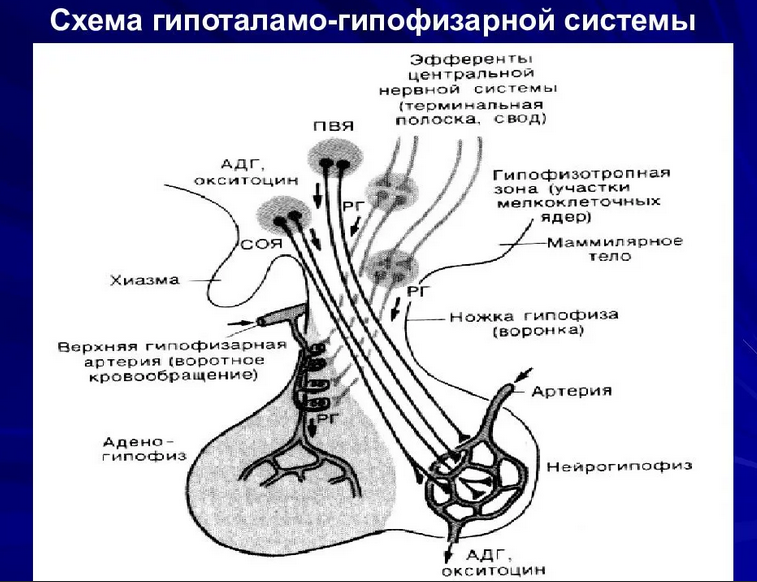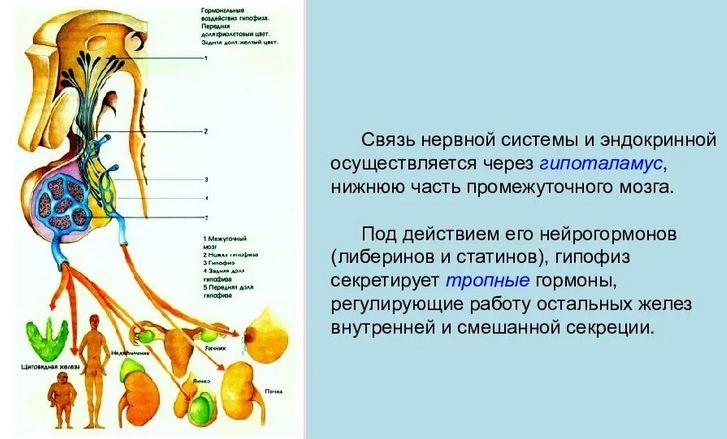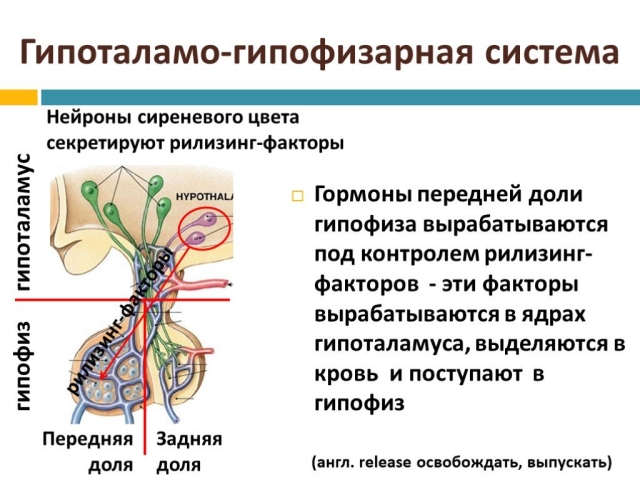A hypothalamic-pituitary system is a human brain axis that is responsible for the development of hormones important for life. Read more in the article.
Content
- The structure of the hypothalamic-pituitary system of the human brain is physiology, anatomy: diagram, concept of “hypothalamus, pituitary gland”
- How the hypothalamic-pituitary system works: features of regulation, functions, processes
- Hypothalamic-pituitary hormones in the human body
- Disorders of the hypothalamic-pituitary system: pathologies of increased concentration of hormones
- Disorders of the hypothalamic-pituitary system: reduced concentration of hormones
- Video: hypothalamic-pituitary system. Normal physiology
- Video: Hormones of the hypothalamus and pituitary gland.
- Video: hypothalamo-pituitary system
A hypothalamic-pituitary axis is a system of two important organs: a hypothalamus and a pituitary gland and their relationship. All elements of this axis are located in the central nervous system, and its most important role is to control the hormonal balance of the whole organism.
Read on our website another article on the topic: “Brain development. 30 exercises for the brain of children, schoolchildren, adults and the elderly ".
Find out how the hypothalamic-pituitary axis works, how it affects the secretion of hormones and when its function can be impaired.
The structure of the hypothalamic-pituitary system of the human brain is physiology, anatomy: diagram, concept of “hypothalamus, pituitary gland”

A hypothalamic-pituitary axis is a human brain system consisting of an endocrine gland, a pituitary gland and part of the brain, hypothalamus. The hypothalamic-pituitary axis is the main regulator of the functioning of all endocrine glands. Here is a scheme and structure:

To understand how the hypothalamus pituitary axis works according to physiology and anatomy, let's first see how two of its main components work: hypothalamus and pituitary gland.
The initial structure:
- The hypothalamus is a real “command center” of the whole organism.
- Its task is to receive incentives regarding the current state of our body, process them and react accordingly to them.
- Hypothalamus is an element that provides signals between the nervous system and the endocrine system.
- The cells of the hypothalamus can recognize information regarding the temperature of our body, the current power state, arterial blood pressure and the concentration of electrolytes.
Thanks to this, the hypothalamus is responsible for managing many aspects of the functioning of the body:
- Hunger and thirst
- Circus rhythm of sleep and wakefulness
- Regulation of metabolism
- The ability to reproduce
From the point of view of the action of the hypothalamic-pituitary axis, the most important activity of the hypothalamus is the development of various hormones that affect the functioning of the whole organism.
The second structure of the hypothalamic-pituitary axis is the pituitary gland:
- It has a slightly more limited range of action.
- Its functioning is subject to great restrictions and constant control, and the most important control is carried out by a hypothalamus.
- Although the pituitary gland does not receive as many stimuli as the hypothalamus, its function should not be underestimated.
- This small structure is the central point of the endocrine system.
- Under the influence of hypothalamus stimuli, the endocrine system produces its own hormones that regulate the operation of other endocrine glands.
The pituitary gland consists of two parts - the anterior (hormonal) and posterior (nervous). The anterior pituitary cells of the pituitary gland produce and release their own hormones of the pituitary gland into the blood. On the other hand, the cells of the rear are a storehouse of two very important hypothalamic hormones - oxytocin and vasopressin.
How the hypothalamic-pituitary system works: features of regulation, functions, processes

The action of the hypothalamic-pituitary system is possible due to the constant connection between these organs. Here are the features of the regulation of processes and the function of this axis:
- Hypothalamus
As a structure of the nervous system, it constantly receives a huge amount of information from all parts of the body. In response, it can generate various types of reactions - stimulate other areas of the brain or produce a hormone, a chemical particle capable of tolerating information. Here are what processes occur in this part of the brain:
- Pituitary
An important mediator in the hormonal activity of the hypothalamus. Hormones of the hypothalamus reach the pituitary gland in two ways. The first - This is a direct transmission of hormones along nerve fibers. So vasopressin and oxytocin are transported. Being produced in the hypothalamus, they go to the rear pituitary gland, from where they then enter the bloodstream.
The second method - With those hormones of the hypothalamus that control the functioning of the pituitary gland. These include various subtypes of the release (exciting hormones) and statins (inhibitory hormones). Hypotalamic liberins and statins move from the hypothalamus to a special network of tiny blood vessels, through which they fall directly into the pituitary gland. In contact with the cells of the anterior pituitary gland, they regulate their activity and the production of pituitary hormones.
Although the hypothalamus is the primary structure of the hypothalamic-pituitary axis, the connection can be bilateral. The pituitary gland also has the ability to influence the hypothalamus. Adjusting the entire axis is based on the so -called positive and negative reviews. When hormones are released from the pituitary gland, their blood levels increase, and the hypothalamic-pituitary system is suppressed. On the other hand, if this hormone is necessary, the hypothalamus stimulates the pituitary gland and increases its secretory activity. The correct functioning of the feedback system is a necessary condition for maintaining homeostasis, that is, the internal balance of our body.
Hypothalamic-pituitary hormones in the human body
The hypothalamus pituitary axis is a “two-story” system with many relationships. None of its structures can fulfill its function on their own. A hypothalamic-pituitary axis is a powerful tool that regulates the entire hormonal balance of our body. The most important hormones in the human body, produced by a hypothalamus and a pituitary gland:
- Oxytocin, vasopressin (ADH)
- Somatoliberin (GH-RH)
- Somatostatin (GH-IH)
- Corticoliberin (CRH)
- Tireoliberin (trh)
- Gonadoliberin (gnrh)
- PRHALIBERIN (PRH)
- Prolactostatin (pih)
As you can see, the hypothalamic-pituitary axis determines the functioning of the whole organism through a huge amount of hormones. The most important functions of hormones on this axis are presented below.
- Oxytocin
Oxytocin and vasopressin are two hormones of the hypothalamus that do not affect the pituitary gland. The role of the pituitary gland is only to store them. As soon as they receive the corresponding signal, they enter the bloodstream. Oxytocin is a hormone that plays the most important role during childbirth. It helps to reduce the uterus. The second task of oxytocin is to alleviate lactation. Sucking a nipple with a baby stimulates the release of oxytocin into the blood of the mother, which leads to the secretion of milk from the chest glands.
- Vasopressin
Also known as antidiuretic hormone (ADG). It is a hormone that regulates the water balance of the body. As the name implies, the antidiuretic hormone reduces diuresis. Vasopressin is released during dehydration, with blood thickening or falling blood pressure. By acting on the kidneys, vasopressin increases the density of diuresis. Thanks to this, you can save water and save it inside the body.
- Somatoliberin
This is the first example of a typical hormone of the hypothalamic-pituitary system. Having developed in the hypothalamus, Somatoliberin reaches the pituitary gland and stimulates its cells to the secretion of the pituitary somatropin, also known as the growth hormone. The axis of Somatotropin-Somatoliberin ensures the growth and development of all body tissues, which, in turn, determines the correctness of the growth process.
- Somatostatin
It is a hormonal enemy of Somatoliberin. Its effect on the pituitary gland leads to a decrease in the emission of growth hormone. In addition to its functions in the hypothalamic-pituitary system, somatostatin is also locally produced in the gastrointestinal tract, where it inhibits, for example, the release of intestinal hormones.
- Corticoliberin
Known as the hormone of the release of corticotropin (ACTH). It is part of the hypothalamic-pituitary-adrenaline system. The most active in stressful situations. The effect of ACTH on the bark of the adrenal glands increases the release of one of the most important "stress hormones" - cortisol. The axis of the corticoliberin-corticotropin-adultery also regulates the metabolic balance of the whole organism.
- Tireoliberin
This is a hormone that causes the release of thyroid -stroke hormone (TSH) from the pituitary gland. The level of thyroidropine is one of the markers indicating the current function of the thyroid gland, therefore it is often measured in patients with diseases of this gland. Tirotropin stimulates the development of the thyroid gland and increases the secretion of its hormones. This, in turn, affects our heart rate, the work of the gastrointestinal tract, the metabolism of nutrients and everyday activity.
- Gonadoliberin
The role of Gonadoliberin in the hypothalamic-pituitary system is to stimulate the production of the so-called gonadotropin of the pituitary gland. It includes: follicle -stimulating hormone (FSH) and Lutpin (LH). Gonadoliberin is an example of a hormone secreted in a pulsating rhythm, and the frequency of this rhythm determines the type of gonadotropin. The low frequency of Gonadoliberin’s impulses causes FSH secretion, and high - LH (this occurs, for example, in women immediately before ovulation). The gonadotropins of the pituitary gland affect the ovaries of women and the testicles of men, determining the correct puberty and reproduction.
- Pro -Liberin
This is a hypothalamic hormone that stimulates the cells of the pituitary gland to produce prolactin. Prolactin is the main factor that prepares the mammary glands for the lactation process. Prolactin secretion with a pituitary gland is a good example of a negative feedback mechanism in a hypothalamic-pituitary axis. During lactation, when the level of prolactin in the body is the highest, the production of gonadotropin is suppressed again. For this reason, menstruation after childbirth does not occur for women breastfeeding.
- Prolactostatin
The hormone, which inhibits the release of prolactin, is basically not a typical hypothalamic statin. Its function is performed by a dopamine neurotransmitter. This is an enhanced dopaminergic transmission of signals in the hypothalamic-pituitary system, which reduces the production of prolactin.
Disorders of the hypothalamic-pituitary system: pathologies of increased concentration of hormones

Although hormone levels in the hypothalamic-pituitary system are mutually controlled, their regulatory mechanisms sometimes do not work. Disorders of the hypothalamic-pituitary system are developing. As a result, a person deals with endocrine pathologies that arise as a result of an excess or lack of hormones of hypothalamic-pituitary gland. Here are diseases that develop due to pathologies of increasing the concentration of hormones of the hypothalamic-pituitary axis:
- Inadequate Products of Vasopressin
An example of the excessive activity of the hormones of the hypothalamus is precisely the syndrome of inadequate products of vasopressin (SIADH). As a result of too high concentration of this substance, an increased water retention in the body and dilution of body fluids is observed. Siadh syndrome mainly causes neurological symptoms, and in its advanced form can lead to cerebral edema.
- Hyperthyroidism or adrenal gland hyperfunction
An increased level of hormones of the hypothalamic-pituitary system can lead to secondary hyperfunction of other endocrine glands-hyperthyroidism or adrenal hyperfunction. A high concentration of ACTH can cause the so-called ACTH-dependent Kushing syndrome. Secondary hyperthyroidism leads to such conditions - ocute pulse, hsubstract weight loss, djaraus.There is also excessive psychomotor excitability.
- Gigantism or acromegaly
Often occurs against the background of these violations. Moreover, it happens in both men and women.
- Infertility
The increased concentration of prolactin, that is, hyperprolactinemia, is one of the most common hormonal causes of infertility. Prolactin suppresses the secretion of gonadotropins of the pituitary gland, which, in particular, leads to ovulation disorders.
- Poofiz adenomas
The most common cause of the elevated level of pituitary gland are pituitary adenomas that get out of the control of the hypothalamic-pituitary system and produce hormones regardless of it. Their symptoms may be the result of increasing the level of one hormone or an overlapping excess of several types of hormones. An increase in the level of peripheral hormones, such as cortisol or thyroid hormones, always requires the exclusion of dysfunction of the hypothalamic-pituitary system that can cause these violations.
Disorders of the hypothalamic-pituitary system: reduced concentration of hormones
The disease with a mechanism opposite to the above SiadH is non -sha shagal diabetes. The cause of this disease is a deficiency of vasopressin produced in a hypothalamus caused by dysfunction of hypothalamic cells. Such disorders of the hypothalamic-pituitary system are very common.
- A decrease in the concentration of vasopressin levels makes the loss of water with urine uncontrolled.
- The amount of urine secreted increases significantly, which leads to symptoms of dehydration and a constant feeling of thirst.
The deficiency of the hormones of the pituitary gland can cause symptoms of secondary insufficiency of the endocrine glands:
- Thyroid gland
- Adrenal glands
- Gonad
It is worth knowing: A decrease in gonadotropins can cause infertility and sexual dysfunction.
The deficiency of thyroidropine leads to secondary hypothyroidism, which manifests itself in the form of chronic fatigue, increase in weight and constipation. A reduced level of growth hormone has serious consequences, especially in children, delaying the growth process. On the other hand, prolactin deficiency can lead to lactation. Hypopithitarism is rarely manifested by a deficiency of one hormone. More often, damage to this gland leads to a decrease in the production of several hormones. The pituitary dysfunction can have different causes. These include:
- Injuries
- Neoplasms that infiltrate pituitary gland
- Bleeding
- Congenital diseases (for example, hypoplasia, that is, underdevelopment of the pituitary gland)
In the diagnosis of hormonal deficiency, you should always not forget to check the functioning of the hypothalamic-pituitary axis (measuring the levels of hormones of this axis). Thanks to this, it is possible to determine whether a deficiency of one or another hormone is the result of a violation of its peripheral production or central violation of hypothalamic-pituitary regulation.
Video: hypothalamic-pituitary system. Normal physiology
Video: Hormones of the hypothalamus and pituitary gland.
Video: hypothalamo-pituitary system
Read on the topic:
- 10 factors affecting the acceleration of the aging process of the brain
- Anatomy - the structure and functions of the human skull: a scheme with a description
- Anatomy - the extrapyramidal motor system of the brain
- Human brain trunk: structure, function, lesion and disease
- Aneurysm of the vessels of the brain: causes of occurrence







